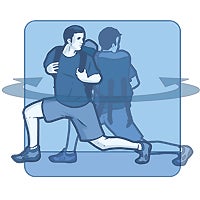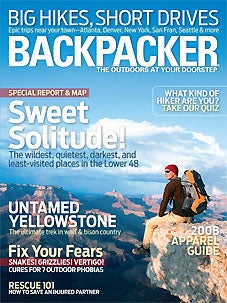Heading out the door? Read this article on the new Outside+ app available now on iOS devices for members! Download the app.
LOST |
INJURED |
CAUGHT IN A STORM
You’re stuck on a high ridge, engulfed in a flurry of thick snowflakes. What began as an overcast October dayhike has become a whiteout, and you can barely see the trail as you stagger against the frigid wind. Should you have seen this coming? Will you survive the cold? The answers depend on choices you made hours ago.
Packing/Planning | Reading the Weather/Deciding to Stay or Go | Surviving the Night/Pitching a Tent/Building a Fire in the Snow
1. Packing
WRONG: Set out with your standard summer dayhiking gear.
RIGHT: In addtion to the 10 Essentials (waterproof map, compass and/or GPS, headlamp, food, water, extra clothes, first-aid kit, matches, firestarter, and raingear), carry enough gear to survive a night in cold, wet, and windy weather, says Anderson. He packs raingear, extra insulating layers, and a windproof jacket on any shoulder-season hike. “Having just a few small things can really save your tail,” adds Brown. For winter trips, bring chemical handwarmers, a thermos of hot soup or tea, two different kinds of firestarter, a plastic sheet for an emergency shelter, and thick foil (or another container) to use for melting snow.
2. Planning
WRONG: Assume the forecast for the nearest city applies to the mountains, too–or don’t check the weather because the sky is blue.
RIGHT: Find backcountry reports at weather.gov or national park websites, or call the local ranger station. Research climate trends and read guidebooks for an idea of what to expect in a given month.
LOST |
INJURED |
CAUGHT IN A STORM
Packing/Planning | Reading the Weather/Deciding to Stay or Go | Surviving the Night/Pitching a Tent/Building a Fire in the Snow
3. Reading the weather
WRONG: Ignore those clouds building on the horizon–the summit is just an hour away!
RIGHT: Watch for thick, dark, anvil-shaped clouds. If bad weather seems to be blowing in, stop and do a “pre-mortem”: If a storm obscures visibility, will you be able to find your way back down? Will you be exposed to lightning? Keep track of warning signs, such as dropping temperatures and increased winds, and use them to convince summit-fevered partners to turn back.
How to spot a coming storm
A. Altostratus: These high, gray clouds often cover the entire sky and indicate prolonged rain or snow is on the way.
B. Nimbostratus: These low, thick, gray clouds block most sunlight and usually bring steady, light- to medium- intensity rain or snow.
C. Cumulonimbus: These towering, anvil-shaped clouds can produce lightning, snow, heavy rain, and hail.

4. Deciding to stay or go
WRONG: Strike out blindly into the storm, trying to feel your way to safety in a whiteout–you have to get outta there, no matter what!
RIGHT: “If the weather’s so bad that you can’t see the trail, you should wait it out,” says Brown. Mark your location on your map or GPS, put on extra layers, then find or build shelter.
LOST |
INJURED |
CAUGHT IN A STORM
Packing/Planning | Reading the Weather/Deciding to Stay or Go | Surviving the Night/Pitching a Tent/Building a Fire in the Snow
5. Surviving the night
WRONG: Get soaked in sweat trying to build a snow cave, which takes too much time and energy to be useful in most survival situations.
RIGHT: In the cold, your priorities are fire, shelter, signaling rescue, water, and food, in that order. Take care of number one by gathering dry wood under rock overhangs, leaves, and logs; finding deadfall snagged in tree branches; or using a knife to shave wet bark from sticks to reach drier wood inside. Rig a tarp to shield the fire from precipitation, then use thumb-width kindling to start a blaze that will dry bigger pieces of wood. Best tools? Try a butane lighter, wax-coated matches, flint firestarter, or Coghlan’s fire sticks (they ignite even when soaked). Pitch your tent or build a snow shelter (see below). Leave markers, such as sticks, to help you find your way back if you must leave your refuge.
How to pitch a tent in the snow
Pack down the snow with your boots, skis, or snowshoes before setting up your tent in a sheltered spot (like the lee side of a boulder). Make deadmen to anchor the tent: Tie guylines to trekking poles, sticks, or rocks, and bury them in the snow with the guyline taut. No tent? Dig a hole in a tree well and cover the ground and walls with leaves or evergreen boughs.

How to build a fire in the snow
Construct a platform out of stones or logs to raise the fire above wet ground.
